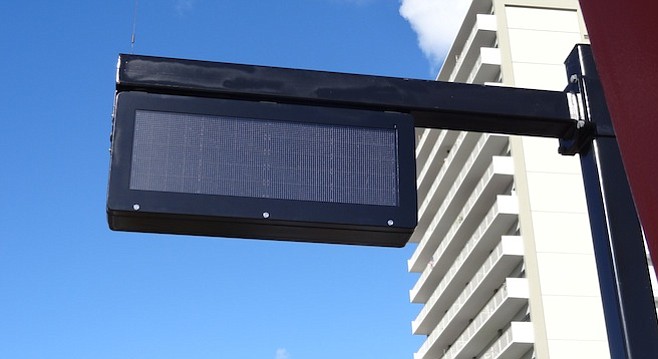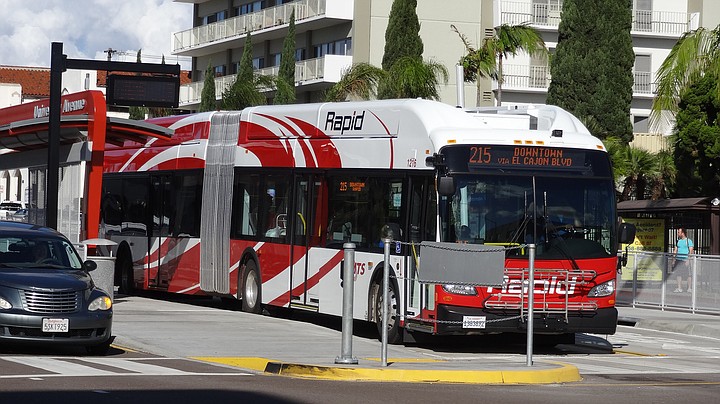 Facebook
Facebook
 X
X
 Instagram
Instagram
 TikTok
TikTok
 Youtube
Youtube

While the limited-stop Rapid 215 bus route has been operating since October 12 (it was scheduled to begin service August 31), it's a different story with the electronic sign technology called Variable-Message Signs. There are printed schedules posted at each new stylish station, but what's with the nonworking digital signs?

I asked Metropolitan Transit System public relations director Rob Schupp, but he passed the buck to SANDAG (San Diego Association of Governments), since he said that organization is “working to get all signs functional.” SANDAG built the new 215 line, in collaboration with the transit system. The budget was reported at $44 million, including the new buses. Schupp also said the transit system is “anxious to get the signs up and working.”
Helen Gao, associate public information officer at SANDAG, had to get specifics from the project manager. Gao explained on December 12 that the signs themselves are OK. “The issue is related to the software, which is a separate purchase and which has to be installed separately,” she said. “We resolved the issue this week, and we expect the signs to be up and running in January.
There are 18 signs on that route. Testing has been ongoing at the Park Boulevard and University Avenue station, Gao told me. That test work “has gone well,” she said. “The signs are at the top of our punch list as we work to close out the project.”
I asked for the breakdown on costs for the electronic signs and the software. “We purchased a total of 20 signs, including two spares, for the Mid-City Rapid project,” Gao said. “The total cost of the physical signs is approximately $207,000. The cost of the software for the signs is approximately $67,000.”
Rapid 215 runs between Santa Fe Station and SDSU, seven days a week from 5 a.m. to 1 a.m. It offers 10-minute service during weekday rush hours, and 15-minute service during non-rush hours/weekends.


While the limited-stop Rapid 215 bus route has been operating since October 12 (it was scheduled to begin service August 31), it's a different story with the electronic sign technology called Variable-Message Signs. There are printed schedules posted at each new stylish station, but what's with the nonworking digital signs?

I asked Metropolitan Transit System public relations director Rob Schupp, but he passed the buck to SANDAG (San Diego Association of Governments), since he said that organization is “working to get all signs functional.” SANDAG built the new 215 line, in collaboration with the transit system. The budget was reported at $44 million, including the new buses. Schupp also said the transit system is “anxious to get the signs up and working.”
Helen Gao, associate public information officer at SANDAG, had to get specifics from the project manager. Gao explained on December 12 that the signs themselves are OK. “The issue is related to the software, which is a separate purchase and which has to be installed separately,” she said. “We resolved the issue this week, and we expect the signs to be up and running in January.
There are 18 signs on that route. Testing has been ongoing at the Park Boulevard and University Avenue station, Gao told me. That test work “has gone well,” she said. “The signs are at the top of our punch list as we work to close out the project.”
I asked for the breakdown on costs for the electronic signs and the software. “We purchased a total of 20 signs, including two spares, for the Mid-City Rapid project,” Gao said. “The total cost of the physical signs is approximately $207,000. The cost of the software for the signs is approximately $67,000.”
Rapid 215 runs between Santa Fe Station and SDSU, seven days a week from 5 a.m. to 1 a.m. It offers 10-minute service during weekday rush hours, and 15-minute service during non-rush hours/weekends.
Comments